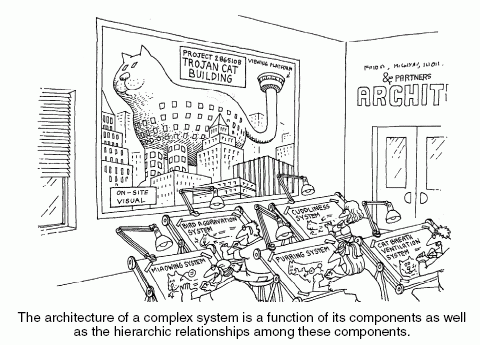Object-Oriented Analysis and Design with Applications | Page 3
[previous] [next]
Complexity
1.3 The Five Attributes of a Complex System
Considering the nature of this complexity, we conclude that there are five attributes common to all complex systems.
Hierarchic Structure
Building on the work of Simon and Ando, Courtois suggests the following:
Frequently, complexity takes the form of a hierarchy, whereby a complex system is composed of interrelated subsystems that have in turn their own subsystems, and so on, until some lowest level of elementary components is reached.
Simon points out that "the fact that many complex systems have a nearly decomposable, hierarchic structure is a major facilitating factor enabling us to understand, describe, and even 'see' such systems and their parts". Indeed, it is likely that we can understand only those systems that have a hierarchic structure.
It is important to realize that the architecture of a complex system is a function of its components as well as the hierarchic relationships among these components. "All systems have subsystems and all systems are parts of larger systems. . . . The value added by a system must come from the relationships between the parts, not from the parts per se".

Relative Primitives
Regarding the nature of the primitive components of a complex system, our experience suggests that:
The choice of what components in a system are primitive is relatively arbitrary and is largely up to the discretion of the observer of the system.
What is primitive for one observer may be at a much higher level of abstraction for another.
Separation of Concerns
Simon calls hierarchic systems decomposable because they can be divided into identifiable parts; he calls them nearly decomposable because their parts are not completely independent. This leads us to another attribute common to all complex systems:
Intracomponent linkages are generally stronger than intercomponent linkages. This fact has the effect of separating the high-frequency dynamics of the componentsÂinvolving the internal structure of the componentsÂfrom the low-frequency dynamicsÂinvolving interaction among components.
This difference between intra- and intercomponent interactions provides a clear separation of concerns among the various parts of a system, making it possible to study each part in relative isolation.
Common Patterns
As we have discussed, many complex systems are implemented with an economy of expression. Simon thus notes that:
Hierarchic systems are usually composed of only a few different kinds of subsystems in various combinations and arrangements.
In other words, complex systems have common patterns. These patterns may involve the reuse of small components, such as the cells found in both plants and animals, or of larger structures, such as vascular systems, also found in both plants and animals.
Stable Intermediate Forms
Earlier, we noted that complex systems tend to evolve over time. Specifically, "complex systems will evolve from simple systems much more rapidly if there are stable intermediate forms than if there are not". In more dramatic terms:
A complex system that works is invariably found to have evolved from a simple system that worked. . . . A complex system designed from scratch never works and cannot be patched up to make it work. You have to start over, beginning with a working simple system.
As systems evolve, objects that were once considered complex become the primitive objects on which more complex systems are built. Furthermore, we can never craft these primitive objects correctly the first time: We must use them in context first and then improve them over time as we learn more about the real behavior of the system.
[previous] [next]
URL:


 Find a programming school near you
Find a programming school near you